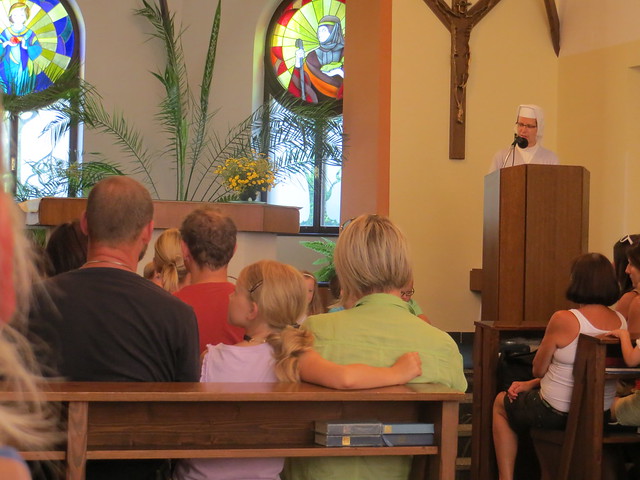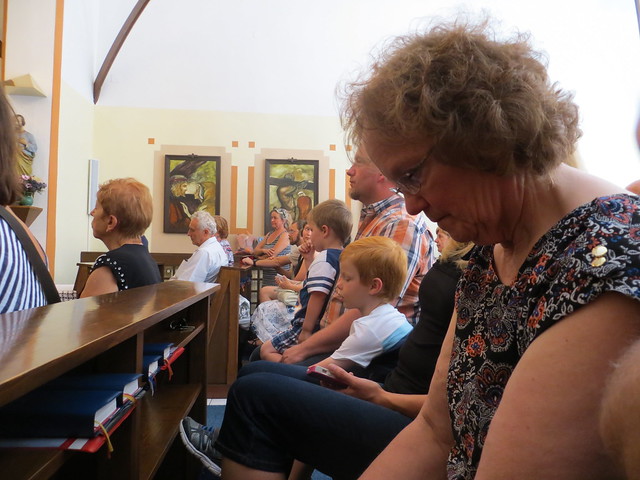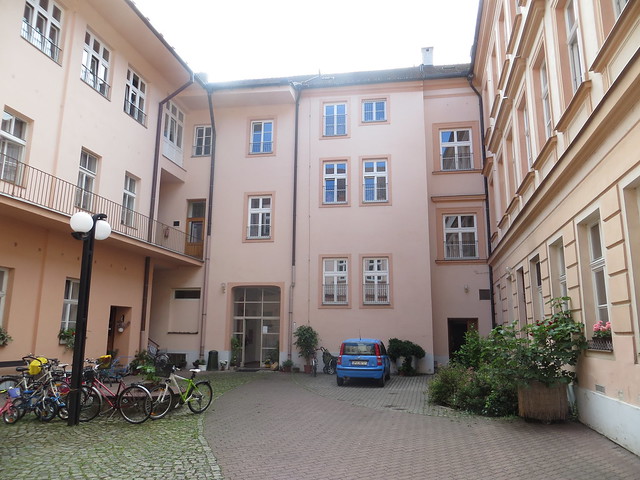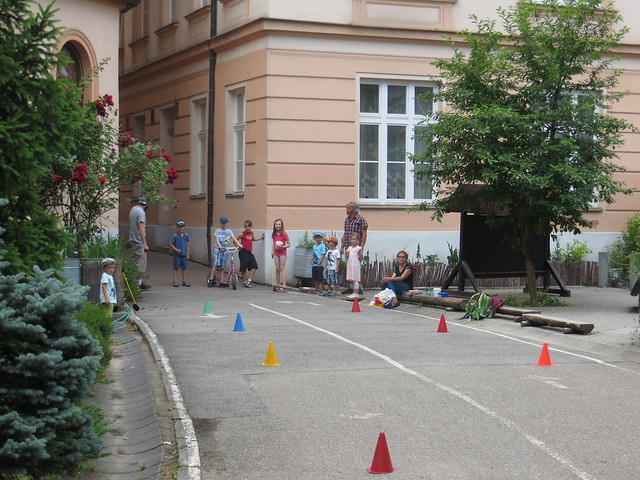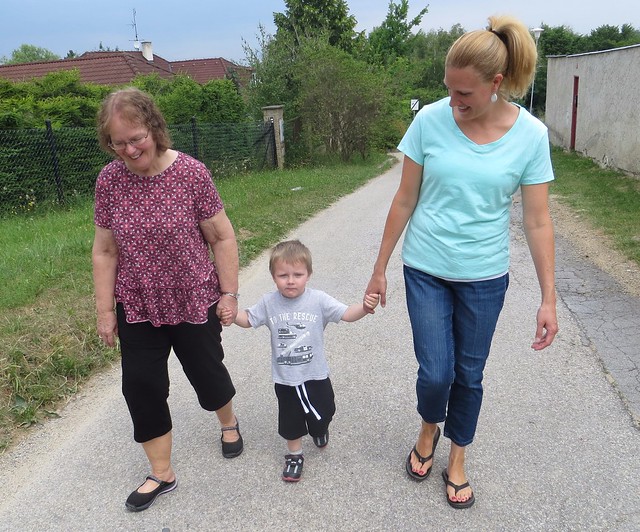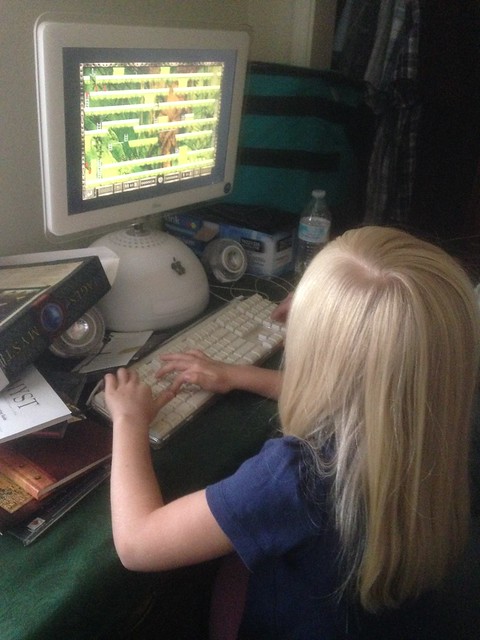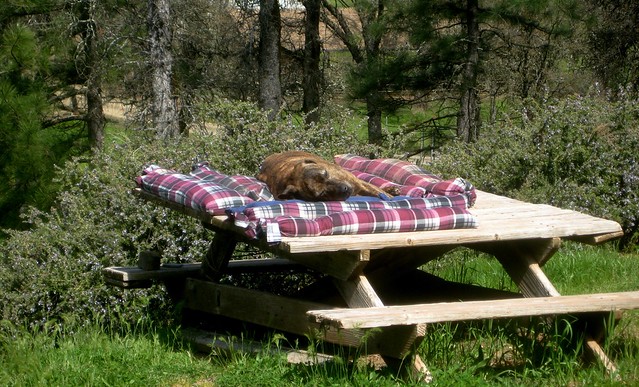My first attempt to solve the whole cube with my eyes closed ended in utter failure. I scrambled a cube. Made another cube look just the same. Studied the cube. Tried to solve it. It was a bit off when I was done. Too far off for me to see what I had done wrong. I tried with the other cube. Except for a few of the corners it was not even close!
I'm wondering if I can come up with a better way. Use commutators to solve the corners? Or maybe I just need to slow down and keep doing it the way I am but open my eyes periodically to check my progress and check mistakes before they become unrecognizable and beyond repair. Perhaps I need a better system of learning the order of pieces. Perhaps I need a better way to hold the cube during the edges solving. Maybe I should just solve a cube by my corners first method a few times to get the feel of it. Maybe I should try solving the corners using commutators...
Thursday, June 29, 2017
Yardwork
If Europeans say garden where I say yard, I guess that means I have been gardening, whereas I thought I was doing yardwork. I've been helping Raymond prune back the blackberry vines that have invaded their yard along one fenceline. As I was working I spotted a snail amongst the thorny branches. Amazing.
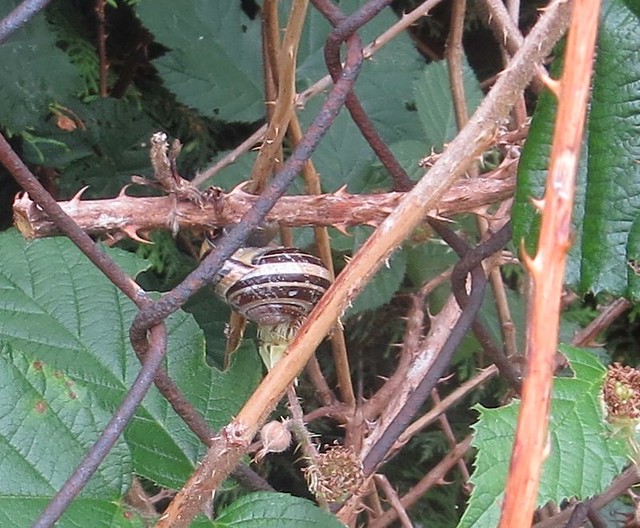

Annie and Alex's School
Sacramento to LA to Madrid to Vienna
The fam picked us up in Vienna. We spent one night there then loaded up and went to McDonalds for breakfast before we headed home. McDonalds in Vienna has a cute little section called McCafe that looks a lot like a little Starbucks. And they serve fancy coffee in actual mugs. I wonder if any McDonalds in the US are like that?
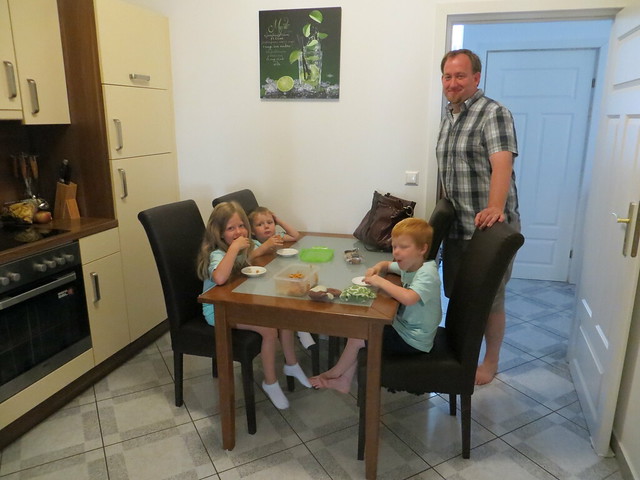
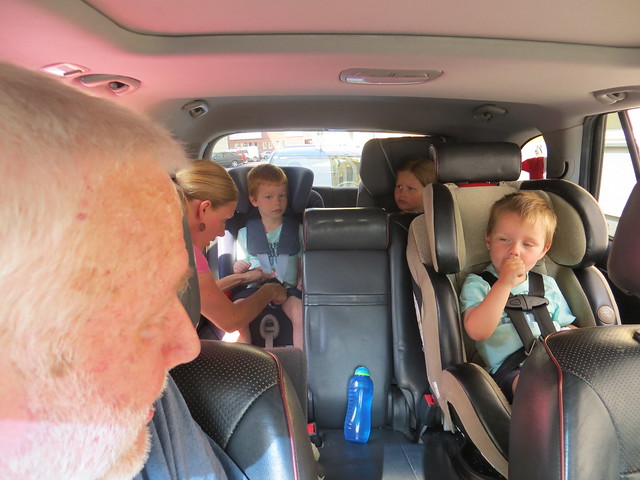

Yes, I know. This is not in exactly the correct order chronologically. Get over it.



Yes, I know. This is not in exactly the correct order chronologically. Get over it.
Wednesday, June 28, 2017
Nice Neighborhood to Walk Around
BLD Edges
Big accomplishment on my way to solving the whole cube with my eyes closed. I just did all 12 edges with my eyes closed from start to finish. How did I do it? Fred Enjoys Oranges. 2 Uses Rags. Vic 1 Golf In 4. Flip DB and RB. Each initial stands for a spot on the cube. ABCD are names for the four top edge faces. EFGH for the edge faces of the left side. IJKL for the edge faces of the front. OPQR for the right. UVWX for the back. 1234 for the bottom. This is the first time I have succeeded in solving all the edges. I've done corners multiple times. Now I guess I should try to do the whole cube. If I can do the whole cube I guess I will time myself just to see how long it takes. I am not into speed solving, but it would be nice to know.
The View From My Bedroom Window Summer 2017
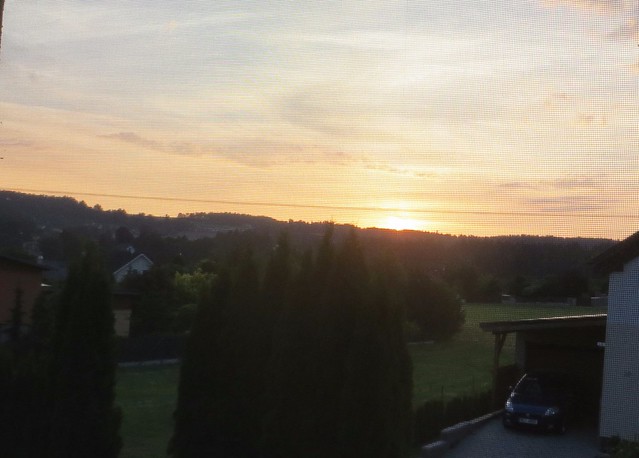
Marae and I are staying in Annie's room this summer and she gets to be in the boys' room for the summer. The accommodations this summer far surpass the ones at the first place Raymond and family lived here. We are so far north that in the summer it starts getting light in the middle of the night. No kidding. But the sun didn't actually rise until about a quarter after 5.
Another great thing about this place is the yard, uh, I mean garden, the kiddos have to run and play in.
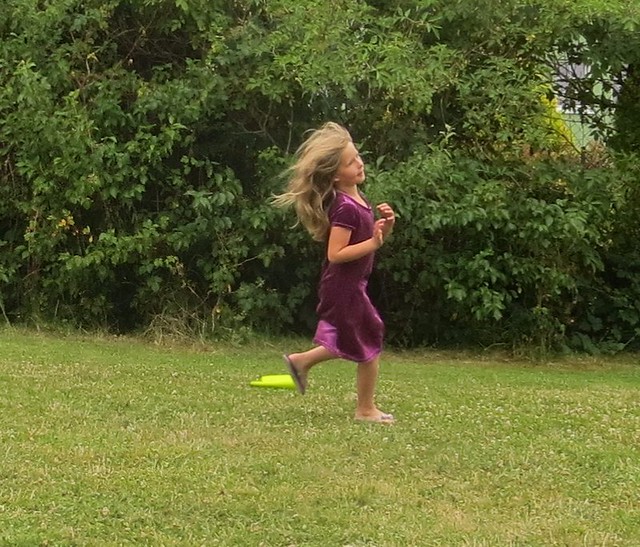

Grammy the washer woman bringing clothes in from the clothesline. :D
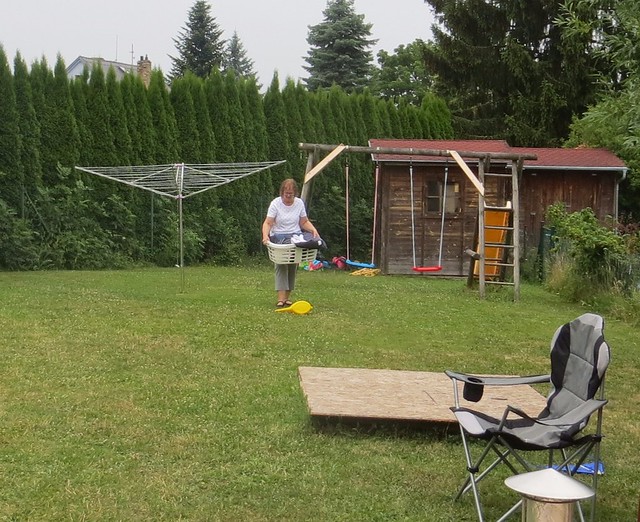
A closeup of my wonderful wife at the table.

And Alex.
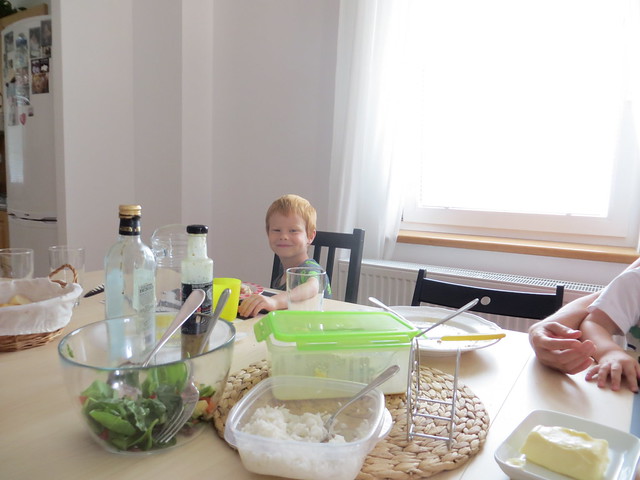
European Magpie
We were hanging out in the backyard at the Lengtats' house in CZ and saw some magpies. One landed in a tree on the fenceline. I didn't have a real clear shot at it but you can see the glaring difference between European magpies and the Yellow-billed Magpie of California.

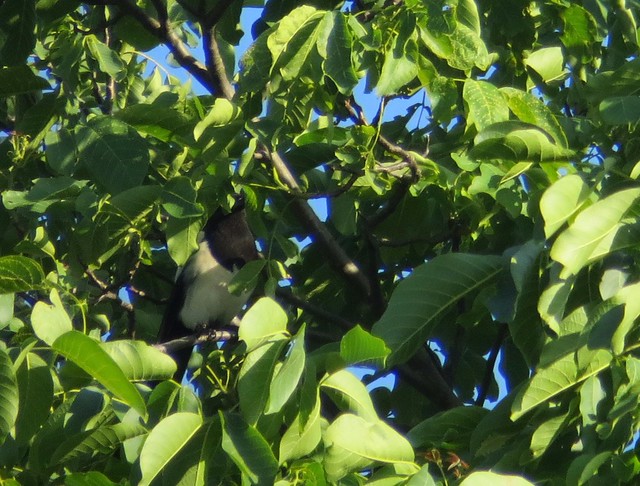
I've also seen some sparrows and some blackbirds and some crows. There are a few others but I have no idea what they are. Maybe I will be able to get some pictures and identify them somehow.


I've also seen some sparrows and some blackbirds and some crows. There are a few others but I have no idea what they are. Maybe I will be able to get some pictures and identify them somehow.
Monday, June 26, 2017
BLD Edges
Today I started working on figuring out a systematic approach to solving the edges. On the one hand the edges seem easier than the corners because there are not so many different groups. But there are more of them. It is nice that the swapping algorithm is exactly the same for edges as it is for corners. It has been helpful to know how to solve the cube by the Corners First Method. So far I have used the Left-Back edge a lot.
Saturday, June 24, 2017
Fine Tuning My BLD Method
The A Group: A, B, C, K, W
The O Group: I, O, U, 1, R
The F Group: E, F, G, H, J
The V Group: V, 4, L, D, P
Think about the Front Right Up corner. Groups A and O go through O and Groups F and V go through J.
Yesterday I worked through the solve a few times and I think I am starting to get what to do with the Green Red White piece. I hold the puzzle with Blue in front and Yellow up.
June 25, 2017
Did it!!!! After many fails I finally got my first solve of the corners today. Far from mastering it and moving on to the edges, but at least there is hope.
June 26, 2017
Did it again!!! One solve; no fails so far today. :) Raymond wants to know when I am going to add the edges to the solve instead of just doing corners. :)
The O Group: I, O, U, 1, R
The F Group: E, F, G, H, J
The V Group: V, 4, L, D, P
Think about the Front Right Up corner. Groups A and O go through O and Groups F and V go through J.
Yesterday I worked through the solve a few times and I think I am starting to get what to do with the Green Red White piece. I hold the puzzle with Blue in front and Yellow up.
June 25, 2017
Did it!!!! After many fails I finally got my first solve of the corners today. Far from mastering it and moving on to the edges, but at least there is hope.
June 26, 2017
Did it again!!! One solve; no fails so far today. :) Raymond wants to know when I am going to add the edges to the solve instead of just doing corners. :)
Friday, June 23, 2017
Blindfolded Solving on the Long Flight from LA to Madrid
I continue to try to work out my own method of BLD. Here is a picture of some notes I made on the flight.
And here is a neat version.
The A Group: A, B, C, D, K, L, W, 4
The O Group: I, O, U, 1
The A Group and the O Group are really both subsets of the O Group. The A Group are the spots that are easy to get to A. From A you go to I then O then 2. Spot 2 is the target for the swap from 3.
The F Group: E, F, G, H, J, P, V
The F Group is different than the A and O Groups because they use RUR' to get to 2 whereas the F Group uses RU'R'.
The R Spot: RUR'U' RUR'
One night I couldn't sleep. I discovered some more helpful BLD sites.
And here is a neat version.
The A Group: A, B, C, D, K, L, W, 4
The O Group: I, O, U, 1
The A Group and the O Group are really both subsets of the O Group. The A Group are the spots that are easy to get to A. From A you go to I then O then 2. Spot 2 is the target for the swap from 3.
The F Group: E, F, G, H, J, P, V
The F Group is different than the A and O Groups because they use RUR' to get to 2 whereas the F Group uses RU'R'.
The R Spot: RUR'U' RUR'
One night I couldn't sleep. I discovered some more helpful BLD sites.
Wednesday, June 21, 2017
What a Flight!
Sacramento to LA on American was good. Roomy seats. Nice. I read a book on the Kindle Fire. I am reading Shame Interrupted by Edward T. Welch. We had to pick up our checked bags and re-check them. We had plenty of time so it wasn't bad.
LA to Madrid was long, crowded, long. I worked a lot on the BLD technique I am trying to develop so that I can solve a Rubik's Cube without looking at it once I study it at the beginning. BLD is an abbreviation for blindfolded. I am not convinced that I will be able to do it, and I have questions about how to accomplish certain aspects, but it was fun working on it when I was able on the flight. This was the flight when the girl behind me asked me to turn off my light. I also tried to read some. I tried watching movies but couldn't get interested since I couldn't hear them through the earbuds I was using. I listened to music on my Fire using my own Apple earbuds eventually.
We had to really hustle in Madrid to get our connecting flight to Vienna. Barely made it. Madrid to Vienna was a drag. So tired. Kept dozing but didn't really sleep much.
I haven't slept much here in the apartment in Vienna that Raymond got. I was exhausted and slept for a couple hours but then woke up and haven't slept much since. It is now 4 am and there are birds chirping outside.
LA to Madrid was long, crowded, long. I worked a lot on the BLD technique I am trying to develop so that I can solve a Rubik's Cube without looking at it once I study it at the beginning. BLD is an abbreviation for blindfolded. I am not convinced that I will be able to do it, and I have questions about how to accomplish certain aspects, but it was fun working on it when I was able on the flight. This was the flight when the girl behind me asked me to turn off my light. I also tried to read some. I tried watching movies but couldn't get interested since I couldn't hear them through the earbuds I was using. I listened to music on my Fire using my own Apple earbuds eventually.
We had to really hustle in Madrid to get our connecting flight to Vienna. Barely made it. Madrid to Vienna was a drag. So tired. Kept dozing but didn't really sleep much.
I haven't slept much here in the apartment in Vienna that Raymond got. I was exhausted and slept for a couple hours but then woke up and haven't slept much since. It is now 4 am and there are birds chirping outside.
Saturday, June 17, 2017
Blindfold Solving
Rory is here for the weekend and to pick up the kiddos and take them home. We will be going to visit Raymond and fam this week and Ro and fam are moving to Washington soon.
Rory asked if I had seen the video of a little boy solving a Rubik's Cube blindfolded. I rarely watch solve videos of any kind nowadays. There was talk in the house about having to have a phenomenal memory to be able to do that. I didn't think so, so looked it up. I read a little and watched part of a video and am ready to try to do blindfold cubing. First I want to do more research on it, but I think I have the gist of solving pieces one by one using just a single algorithm. The algorithm is not the one that was given in the video. I am not going to learn any new algorithms to do this. Nor do I know the 5 or so algorithms in the article I read. I don't think they are necessary. I think I can do the whole cube with just one algorithm that I already know. The hard part will be memorizing the 20 key stickers in order. I think I will start with corners and see if I can just master that. Then add the edges later.
The video I watched part of is by J Perm.
The article I read part of is at ruwix.com.
After watching some and reading some I figured I would see if my idea to use the algorithm that came to mind might work. It works! I solved a scrambled cube using setup moves and one algorithm.
The algorithm: ( R'URU' R2 ) y ( L'U'LU ) y' x ( RUR'U'R2 ) x' U'
y = turn the entire cube so the Right face is in Front
x = turn the entire cube so the Bottom face is in Front
What does it do?
It swaps ULB and UBR.
It swaps UR and UL.
Might want to check out the different methods in the list on this page. I get the impression that most people that are interested in BLD solving are speedcubers. You know what that means. They want to memorize more algorithms to speed things up. The thing I like about the method I am working on devising is that it only uses one algorithm and I already know it.
A lot of blindfolded solvers memorize the cube using Speffz.
I've been thinking about a lettering/numbering scheme for memorizing and came up with something I haven't seen online but it makes sense to me.
U starts with A; L starts with E; F starts with I; R starts with O; B starts with U; D starts with 1.
I also need to get setup moves down—how to get any corner to ULB oriented correctly.
June 19, 2017
In thinking about the setup moves I realize there is a lot of work with the Left, Back, and Down faces. Pain. I am more used to working with Right, Front, and Up faces. So now I am thinking that I should move the corner that I want to swap to to DRF using the Up, Front, and Right faces, then twist the whole cube so the swap algorithm can be done, then twist the whole cube back to undo the setup move. When I say setup move what I mean is moving the ... nevermind, do I really want to develop an extravagant vocabulary to describe this process?
Rory asked if I had seen the video of a little boy solving a Rubik's Cube blindfolded. I rarely watch solve videos of any kind nowadays. There was talk in the house about having to have a phenomenal memory to be able to do that. I didn't think so, so looked it up. I read a little and watched part of a video and am ready to try to do blindfold cubing. First I want to do more research on it, but I think I have the gist of solving pieces one by one using just a single algorithm. The algorithm is not the one that was given in the video. I am not going to learn any new algorithms to do this. Nor do I know the 5 or so algorithms in the article I read. I don't think they are necessary. I think I can do the whole cube with just one algorithm that I already know. The hard part will be memorizing the 20 key stickers in order. I think I will start with corners and see if I can just master that. Then add the edges later.
The video I watched part of is by J Perm.
The article I read part of is at ruwix.com.
After watching some and reading some I figured I would see if my idea to use the algorithm that came to mind might work. It works! I solved a scrambled cube using setup moves and one algorithm.
The algorithm: ( R'URU' R2 ) y ( L'U'LU ) y' x ( RUR'U'R2 ) x' U'
y = turn the entire cube so the Right face is in Front
x = turn the entire cube so the Bottom face is in Front
What does it do?
It swaps ULB and UBR.
It swaps UR and UL.
Might want to check out the different methods in the list on this page. I get the impression that most people that are interested in BLD solving are speedcubers. You know what that means. They want to memorize more algorithms to speed things up. The thing I like about the method I am working on devising is that it only uses one algorithm and I already know it.
A lot of blindfolded solvers memorize the cube using Speffz.
I've been thinking about a lettering/numbering scheme for memorizing and came up with something I haven't seen online but it makes sense to me.
U starts with A; L starts with E; F starts with I; R starts with O; B starts with U; D starts with 1.
I also need to get setup moves down—how to get any corner to ULB oriented correctly.
June 19, 2017
In thinking about the setup moves I realize there is a lot of work with the Left, Back, and Down faces. Pain. I am more used to working with Right, Front, and Up faces. So now I am thinking that I should move the corner that I want to swap to to DRF using the Up, Front, and Right faces, then twist the whole cube so the swap algorithm can be done, then twist the whole cube back to undo the setup move. When I say setup move what I mean is moving the ... nevermind, do I really want to develop an extravagant vocabulary to describe this process?
Sunday, June 11, 2017
Roriana Playing Loderunner
I Have More Time Than Money
I think that if only I had more money left over at the end of the pay period, I would give more to missions.
I have more time than money.
How much time do I have that I spend on frivolous pursuits rather than on deepening my relationship with God?
I have more time than money.
How much time do I have that I spend on frivolous pursuits rather than on deepening my relationship with God?
Tuesday, June 6, 2017
2x3x4 Camouflage Cuboid
I bought the puzzle in 2014. Was mystified for a whole year. Finally solved it in August 2015. Played with it a short while then as far as I know I did not solve it again until yesterday. I just haven't been drawn to it since then. How did it attract me now? I put all my puzzles into Amazon boxes. Instead of all different sized boxes I decided to try more uniform sized boxes. The 2x3x4 Camouflage was not solved so it didn't sit flat in the box. I wanted to be able to store it in cuboid shape.
I tried and made some progress but finally decided to consult my notes. They are all in this blog. The notes jogged my memory and I solved it. I am not real comfortable with it at this point though. I think I solved it enough a couple years ago to get it down. I want to solve it enough to get good at it again.
So far I am totally not getting it!
I just reread something from a past post and I think I see what I am doing wrong. I think I get it now. It says, "Twisting Corner Blocks. Using 2x2x2 moves do things like ( R U Ri Ui ) x 2 or ( R Ui Ri U ) x 2 or the left-handed versions, to orient corner blocks. Only one corner on the bottom layer gets twisted, so the bottom is the working layer where pieces are paired up. Three pieces in the top layer get twisted, but since they are corner blocks, already reduced corners do not get unreduced."
June 7, 2017
With the info in the paragraph above and the center-solver in a past post I think I have it. Now if only I can keep at it long enough to really get it down.
June 8, 2017
Put a real good scramble on it last night then worked at solving it off and on (if you know what I mean) until I reached this point. Thought I'd take a picture and show Roark and Roriana before I finished the solve. (somewhere along the line I deleted pics from Flickr so the link was broken so I removed the link on 5/12/20)
June 9, 2017
It has been going well except for one thing. Sometimes the center pieces do not have to cycle from Bottom Back to Bottom Front to Top Back or Bottom Front to Bottom Back to Top Back, and I see no simple way around it. I thought I did have a way. Do Top to Top to Bottom, but I messed up and ended up scrambling edges including one of the yellow ones. I'm not sure I messed up. Maybe it just doesn't work. But why not? I think I messed up. Well, let's do some re-solving and see....
When I re-solved it the centers were solvable with one of the two algorithms I have in my arsenal. I fiddled around trying to figure out another one but didn't, so put a good scramble on it and then started solving it again.
June 10, 2017
Turns out that from the solved state if you do the Corners First 2 pair algorithm it makes steps! Cool!
I tried and made some progress but finally decided to consult my notes. They are all in this blog. The notes jogged my memory and I solved it. I am not real comfortable with it at this point though. I think I solved it enough a couple years ago to get it down. I want to solve it enough to get good at it again.
So far I am totally not getting it!
I just reread something from a past post and I think I see what I am doing wrong. I think I get it now. It says, "Twisting Corner Blocks. Using 2x2x2 moves do things like ( R U Ri Ui ) x 2 or ( R Ui Ri U ) x 2 or the left-handed versions, to orient corner blocks. Only one corner on the bottom layer gets twisted, so the bottom is the working layer where pieces are paired up. Three pieces in the top layer get twisted, but since they are corner blocks, already reduced corners do not get unreduced."
June 7, 2017
With the info in the paragraph above and the center-solver in a past post I think I have it. Now if only I can keep at it long enough to really get it down.
June 8, 2017
Put a real good scramble on it last night then worked at solving it off and on (if you know what I mean) until I reached this point. Thought I'd take a picture and show Roark and Roriana before I finished the solve. (somewhere along the line I deleted pics from Flickr so the link was broken so I removed the link on 5/12/20)
June 9, 2017
It has been going well except for one thing. Sometimes the center pieces do not have to cycle from Bottom Back to Bottom Front to Top Back or Bottom Front to Bottom Back to Top Back, and I see no simple way around it. I thought I did have a way. Do Top to Top to Bottom, but I messed up and ended up scrambling edges including one of the yellow ones. I'm not sure I messed up. Maybe it just doesn't work. But why not? I think I messed up. Well, let's do some re-solving and see....
When I re-solved it the centers were solvable with one of the two algorithms I have in my arsenal. I fiddled around trying to figure out another one but didn't, so put a good scramble on it and then started solving it again.
June 10, 2017
Turns out that from the solved state if you do the Corners First 2 pair algorithm it makes steps! Cool!
Friday, June 2, 2017
Meier-Halpern Pyramid (Jing's Pyraminx)
Originally posted on September 6, 2011 on my Google site.
Solution 1
This is the original method I came up with. I have some new ideas, so made a new solution (2). Then I decided I liked Rupert's method best for doing the Crazy Tetrahedron and adapted it for the JP (3).Corners and Centers
Like the Skewb’s first 4 corners, solving the corners of the Jing’s Pyraminx is simple and only requires a few twists. If the centers are not solved after solving the corners, then a double swap is needed. Hold the puzzle so that an edge is in front, a corner is at the top, another at the bottom, another at the back on the right, and the other at the back on the left. We can call the corners U, D, R, and L. Let's call the centers R, L, D, and B. To swap centers R with L, and D with B, do corners R' L R L'. Or you could accomplish the same thing with L R' L' R. Or R L' R' L. Or L' R L R'. Different things happen to the edges with each, so if you want to think about the edges while swapping centers...Cycling 3 Edges
Hold the puzzle so a center is facing you. That makes 3 corners visible. U, D, and L (starting at top and going clockwise). Or you could think of it as U, R, and D (starting at top and going clockwise). There are 3 edges on front. Call them 1, 2, and 3. Move 1 to 2. Move 3 to where 1 is now. Undo the first move. Undo the second move. Repeat these 4 moves. Example: ( D' L D L' ) x 2 moves 1 > 3 > 2, and leaves the color on the front of 1 on the front. The other two are flipped. This is similar to the EPS move of the Ultimate Solution. It has to be done twice to restore the corners that get swapped each time.Flipping 2 Edges
If two edges need to flip hold the puzzle so one is between corners D and R, and the other is between corners D and L. Use a setup move if necessary.
R moves the RD edge up. U' moves it away. R' moves its spot back down. D' moves its spot back up flipped. U' moves the RD edge back into its spot. D moves RD and its spot back home, flipped correctly.
U sets up the temporarily scrambled pieces to get unscrambled.
L' moves the LD edge up. U moves it away. L moves its spot back down. D moves its spot back up flipped.
Solution 2
Corners
Like the Skewb’s first 4 corners, solving the corners of the Jing’s Pyraminx is simple and only requires a few twists.
Notation
Hold the puzzle so a center is facing you and three corners are on the bottom. Let's call the one on the bottom right front R, the one on the bottom left front L, and the one on the bottom in the back B. Call the one on top U.
Edges
Hold the puzzle so a center is facing you. That makes 3 corners visible—U, R, and L. There are 3 edges on front. Call them 1, 2, and 3. Move 1 to 2. Move 3 to where 1 is now. Undo the first move. Undo the second move. Example: If 1 is between R and U, 2 is between R and L, and 3 is between L and U, then ( R' L R L' ) moves 1 > 2 > 3, and leaves the color on the front of 3 on the front. The other two roll into place, as it were. This is similar to the EPS move of the Ultimate Solution for solving a Rubik's Cube.
If you are on the last 3 edges and the centers are placed correctly, do 3 > 2, 1 > 3, undo, undo. Do it again. The net result is to cycle 1 > 2 > 3, with 3's front color staying on front.
Flipping 2 Edges
If two edges need to flip hold the puzzle so one is between corners L and R, and the other is between corners B and L. Use a setup move if necessary.
( R U' R' L' U' L ) (twist the base to the right) ( L' U L R U R' ) (twist the base to the left)
( R U' R' L' U' L ) (twist the base to the right) ( L' U L R U R' ) (twist the base to the left)
Swap Centers
The centers get swapped with every edge 3-cycle, so maybe they are solved, and maybe not. If not, ( R' L R L' ) x 3 swaps the front and bottom centers, and swaps the right and left centers.
Rotating Centers
Hold it so one face is in front, and one is on bottom. The front center will rotate anticlockwise, and the left center will rotate clockwise. Do the following twice in a row. 1. R' L R L' 2. Roll the front to the bottom and the left to the front.
3. R' L' R L 4. Roll the bottom to the right. 5. L R' L' R 6. Roll the front to the bottom and the right to the front. 7. L R L' R' 8. Roll the bottom to the left.
3. R' L' R L 4. Roll the bottom to the right. 5. L R' L' R 6. Roll the front to the bottom and the right to the front. 7. L R L' R' 8. Roll the bottom to the left.
Solution 3 (rline inspired)
Terminology
When you turn a Face of the JP you are turning half the puzzle pieces—3 corners, 3 edges, and a center. The other half is a Corner made up of a corner, 3 edges, and 3 centers.
Centers
Like a Rubik's Cube, the centers always stay solved relative to one another.
Edges
Solve the edges of one color. No algorithms are necessary. Not even EPS. Use EPS with Faces to solve the last 3 edges. Holding a Face on top works well.
Corners
Hold the puzzle with a Face forward and 2 corners on bottom. Call the Face on the left L, and the Face on the right R. ( L'RLR' ) x 3 will swap the two corners on the bottom with each other, and the two on the top with each other. The colors on the corners on the front Face on the bottom will stay the same after the swap, so it is preferable they are the same as the center on the front. The color on the front of the top corner will move to the back Face and the one on back to the front.
Case 1: All are in the right place but at least two are twisted. Hold two twisted corners on top, and do ( L'RLR' ) x 3. Go to Case 2.
Case 2: Double Swap needed.
Holding the Front Face still, twist the back half of the puzzle so the center on back matches the color of the top corner that is in front.
( L'RLR' ) x 3 If necessary, and if possible, twist the Front Face, or back half, to complete the solve. If necessary, go to Case 1.
Case 3: One is in the correct place, and may or may not be twisted.
Twist the Face which will place all 4 corners in their correct spots. They may or may not be twisted. Use setup moves and EPS to re-solve the edges. Go to Case 2.
Thursday, June 1, 2017
Sweet Molly
I don't remember why we had the sandbags on the table like that but evidently Molly figured it was for her comfort.
Crazy Tetrahedrons
I ran across the following unpublished page today. Notice what I said at the bottom. It has been more than a couple years but I have no interest in starting fresh or messing with them at all! 😏
Orient the White Center—at most 1 twist.
Outer Corners must be solved relative to one another, or in a double swap—at most 2 twists.
Inner Edges—hold white on the bottom and use The Move.
Outer Edges—hold white on the back and use setup moves and The Move.
Inner Corners—hold white on the bottom and an edge forward, and use the algorithms below which are all commutators built using The Move.
Outer Corners—hold white on either front or back and use variations of The Move x 3 to permute and orient the corners.
The L Move = L R' L' R
The R' D' Commutator = (R' Move) D' (L Move) D = (R' L R L') D' (L R' L' R) D
The L D Commutator = (L Move) D (R' Move) D'
The R' D Commutator = (R' Move) D (L Move) D'
The L D' Commutator = (L Move) D' (R' Move) D
Pieces are named with 2 letters, the first indicating the face, and the second the position on the face. For example DL = the Down face, piece on the Left.
To move DF > DR > DL > LU > BU do The R' D' Commutator.
To move DF > DL > DR > RU > BU do The L D Commutator.
To move DR > DF > RU do the L D' Commutator followed by the L D Commutator.
To move DL > DF > LU do the R' D Commutator followed by the R' D' Commutator.
Standard
Solve the Crazy Tetrahedron just like a Skewb Pyraminx. The "inner corners" are really part of the outer edges, so when you solve the outer edges the "inner corners" solve too. The "inner edges" are really part of the centers. For example, the blue, yellow, and white "inner edges" that are adjacent to the orange side all move with the orange center. So in this puzzle the orientation of the centers matters.Mercury
Mercury has one 1 face and 3 0 faces. Standard has 4 0 faces. I made my Mercury by converting my Standard. I flipped the inner center piece on the white face, since the white face had alignment issues that made it not so enjoyable to play with. The normal store bought Mercury has orange as its 1 face. Unlike its Skewbish puzzle cousins, I no of only one way to solve Mercury. Here are the steps.Orient the White Center—at most 1 twist.
Outer Corners must be solved relative to one another, or in a double swap—at most 2 twists.
Inner Edges—hold white on the bottom and use The Move.
Outer Edges—hold white on the back and use setup moves and The Move.
Inner Corners—hold white on the bottom and an edge forward, and use the algorithms below which are all commutators built using The Move.
Outer Corners—hold white on either front or back and use variations of The Move x 3 to permute and orient the corners.
Inner Corner Algorithms
The R' Move = R' L R L'The L Move = L R' L' R
The R' D' Commutator = (R' Move) D' (L Move) D = (R' L R L') D' (L R' L' R) D
The L D Commutator = (L Move) D (R' Move) D'
The R' D Commutator = (R' Move) D (L Move) D'
The L D' Commutator = (L Move) D' (R' Move) D
Pieces are named with 2 letters, the first indicating the face, and the second the position on the face. For example DL = the Down face, piece on the Left.
To move DF > DR > DL > LU > BU do The R' D' Commutator.
To move DF > DL > DR > RU > BU do The L D Commutator.
To move DR > DF > RU do the L D' Commutator followed by the L D Commutator.
To move DL > DF > LU do the R' D Commutator followed by the R' D' Commutator.
Mars and Saturn
Early May 2013 I tried working through Mars but couldn't get into it. It has been about a year since I last solved them. I would sort of like to just forget them for a couple years then start from scratch without notes.
Subscribe to:
Posts (Atom)
